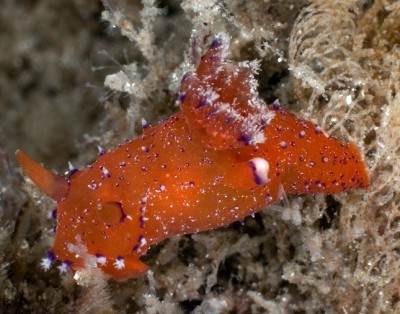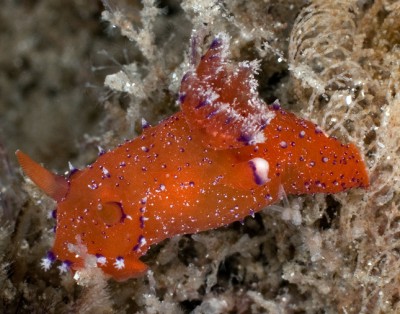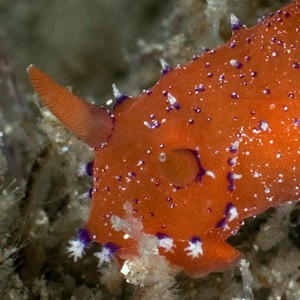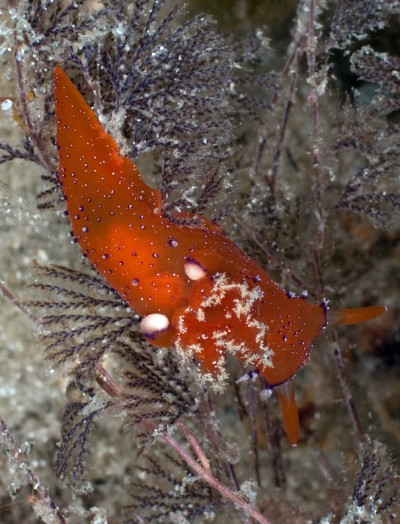
Plocamopherus lucayensis
Hamann & Farmer, 1988
Order: NUDIBRANCHIA
Superfamily: ANADORIDOIDEA
Family: Polyceridae
Subfamily: Triophinae
DISTRIBUTION
Known from a few Caribbean records - Bahamas (Hamann & Farmer, 1988), Curacao (Valdes et al, 2006), Florida (message #22479).
PHOTO
Locality: Lake Worth Lagoon, 15 feet, Florida, USA, Atlantic, 25 April 2009, Tidal, intracoastal. Length: 1.5 inches. Photographer: Linda Ianniello.
The animal is a translucent reddish brown with scattered white papillae of varying sizes all over the body. Most papillae have a basal ring of dark brown to purple. The number of papillae vary in different specimens. In shape, the body is similar to other species of the genus with a lateral ridge around the anterior end of the body which bears papillae with multiple branches at the tip. These papillae are white with a purple to dark brown basal ring. In descriptions and photos I have seen, there appears to be only one pair of large lateral papillae present in this species situated on either side of the gills. They are the same orange - brown colour of the body, except for a white tip and subterminal purple - dark brown band.
It is reported to grow to at least 40 mm in length. Hamann & Farmer report they did not see their animals either swimming or emitting light from the lateral papillae. Valdes et al (2006) report that it produces flashes of light when disturbed.
-
Hamann, J. C. and W. M. Farmer. 1988. Two new species of Plocamopherus from the western warm water Atlantic The Veliger, 31 68-74.
Rudman, W.B., 2009 (May 27) Plocamopherus lucayensis Hamann & Farmer, 1988. [In] Sea Slug Forum. Australian Museum, Sydney. Available from http://www.seaslugforum.net/find/plocluca
Related messages
Re: Plocamopherus lucayensis from Florida
May 28, 2009
From: Linda Ianniello
Concerning message #22479:
Regarding the flashing, I saw that reference also, and no, I did not see any flashing. I did find them on a night dive (there were three together) and was attracted by the bright color. So there was definitely no flash of light to attract me. Then once I found them, I had my dive light or camera focus light on them, so that would have drowned out any flashing. So sorry, I can't confirm that they "flash".
Regards,
Linda I.
lindai1@bellsouth.net
Ianniello, L.M., 2009 (May 28) Re: Plocamopherus lucayensis from Florida. [Message in] Sea Slug Forum. Australian Museum, Sydney. Available from http://www.seaslugforum.net/find/22505Thanks Linda,
Bill Rudman
Rudman, W.B., 2009 (May 28). Comment on Re: Plocamopherus lucayensis from Florida by Linda Ianniello. [Message in] Sea Slug Forum. Australian Museum, Sydney. Available from http://www.seaslugforum.net/find/22505Plocamopherus lucayensis from Florida
May 27, 2009
From: Linda Ianniello

Dr. Bill,
Attached is what I believe is Plocamopherus lucayensis from the Atlantic, which looks a lot like your sp. 1 [message #884] from the Philippines!
Locality: Lake Worth Lagoon, 15 feet, Florida, USA, Atlantic, 25 April 2009, Tidal, intracoastal. Length: 1.5 inches. Photographer: Linda Ianniello.
Regards,
Linda I.
lindai1@bellsouth.net



Dear Linda,
Thanks for these photos of P. lucayensis, which makes its first appearance on the Forum. In their description of this species, Hamann & Farmer mention that it was found on a bryozoan belonging to the family Bugulidae, and the 'weedy' growth in your photo is almost certainly the same bryozoan. Your animal has definite similarities to Plocamopherus sp. 1. from the Philippines, and considering your animal apparently feeds on bugulid bryozoans which are well-known foulers of ships' bottoms, hitchhiking around the world is a possibility. However Plocamopherus sp. 1 has three pairs of large lateral papillae while P. lucayensis appears to have only a single pair. I guess we will need to keep an eye out for more specimens of both species so we can find out juts how variable in colour and body shape they both are.
I am interested to note that Valdes et al., in Caribbean Sea Slugs, note that this species produces flashes of light when disturbed, while Hamann & Farmer specifically state that they did not observe this phenomenon. Have you seen it do this? You would only see it on a night dive or in an aquarium, and often a well-known 'flasher' like P. imperialis won't perform, so I would be interested to know whether the mention in Caribbean Sea Slugs was based on soemone's personal observations or if I have missed a reference to this phenomenon.
Best wishes,
Bill Rudman
